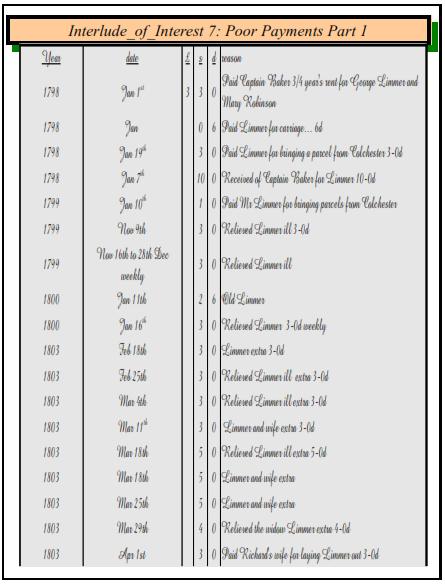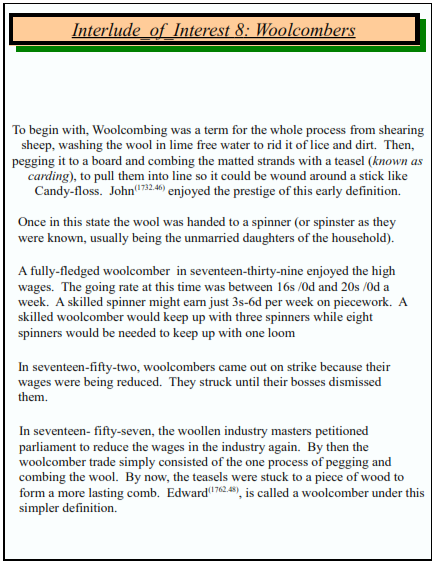Chapter 18 A Sad Generation
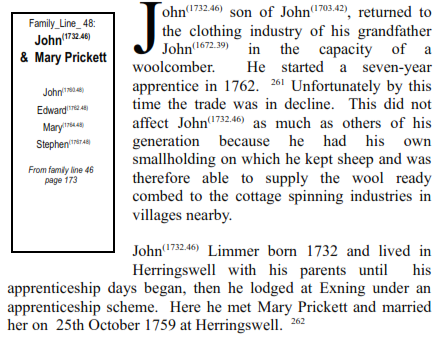
Although the marriage licence has John as a Woolcomber, the term Woolcomber had now changed. As applied to John, 'Woolcomber' meant that he processed the wool from his sheep from sheep shearing combing and bailing ready for spinning. This wool was then taken around the village where almost every home had a spinning wheel. Once spun by the womenfolk it was sold to the clothiers who turned it into garments. The days when this arrangement allowed apprentices to learn the whole process of a clothier were receding while the days of specialisation were fast approaching.
Cotton imports, the spinning Jenny, and the worsted trade re-defined the term woolcomber. Soon after the birth of his second son Edward in 1862, woolcombing was reduced to the single operation in the a factory. The term later became replaced by the term ‘Carding’263. By then, wool manufacturing had taken on a new look. New factory owners built separate workplaces from their homes and streamlined the process under a factory roof. Women no longer worked from home but were crowded together in noisy, hazardous buildings for twelve to fifteen hours a day.
Herringswell, was a down market village with many of its inhabitants on the poor register. John's(1732.46) piece of land was about half a mile from Herringswell Church, (and probably a mile further from his house outside the other side of the village).264. ...
After John(1732.46), aged 27, married Mary Prickett widow. of Exning at Herringswell on the 24th October 1759, they lived in Mary's home at Exning for the first year.
1) First born son: John(1760.48) was baptised 27th September 1760 at Exning. Church.
Maybe because of the increasing competition in the clothing industry, they downsized to a cheaper property in Herringswell in 1761, the couple had their second son
2) Edward(1762.48) baptised 10th June 1762 Herringswell.
3) Mary(1764.48) baptised 4th April 1764 Herringswell.
4) Stephen(1767.48) baptised 25th July 1767 Herringswell, and buried in Herringswell 1768.
With the extra cash raised from the sale of the house, and a bit of assistance from John's(1732.46) father he bought a piece of land. His father John(1703.42), was well known in and around Tuddenham.265
One night, during the extreme weather of 1799, John(1732.46) dutifully went from his house to his field of sheep when the weather caught him out He could not get back home and neighbours found him in the fields where he died. John(1732.46) was buried in Woodditton on 5 Feb 1799 aged forty-one. The local paper holds a report of the inquest . It is not known when Mary died.
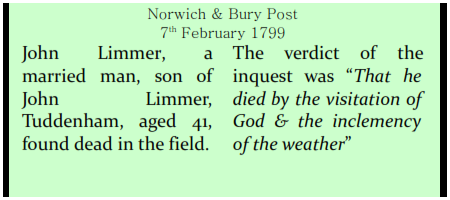
William(1733.46) Younger brother of John(1732.46), having chosen a career as a miller, married Diana About 1762, William. Diana was born in 1739 and was buried, aged 58, on 7th December 1797 Tuddenham266.
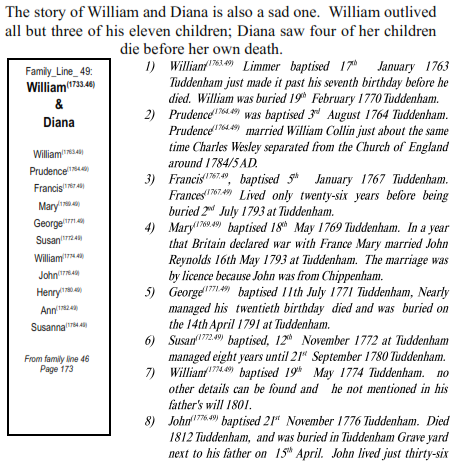
years.
9) Henry(1780.49) baptised 11th May 1780 Tuddenham died twenty years later being buried 7th August 1800 Tuddenham.
10) Ann(1782.49) baptised 1st August 1782 Tuddenham She married John Branwhite 25th February 1801 Tuddenham. John was from Lavenham. The story of Ann and John Branwhite continues in Family_Line_ 60 on page 202.
11) Susanna(1784.49) baptised 9th August 1784 barely saw seventeen years of life before dying at Tuddenham, in 1801.

The marriage was at Barrow by licence suggesting Edward was only lodging in Barrow while working in a newly built textile factory267. Edward was listed as a woolcomber from Tuddenham. Mary was born Norton C1747 and moved to Barrow with her family while in her childhood years. Barrow in the seventeen-nineties was a fast growing village of mainly lower working class folk,268 just ripe for the new textile factory to spring up.
Edward’s character can be seen in his life style. His life was far from easy but he appears to remain faithful to his family and resolute to life throughout his adverse circumstances. We might ask why Edward ended in a factory, essentially as a carder and did not join the rest of his family in a branching out in business?
Edward shares many traits in common with a learning difficulty. Edward would have been just four years old when his mother died and five years old when a stepmother moved in to the home. Was there a character clash between his stepmother and himself? He shows rebellious signs. Later he displays an inability to handle money – perhaps because he could not see the future. one of Edward's children appears to inherit learning difficulties also. Edward’s(1737.46) lack of interest, (or was it inability), in providing his children with a good education is in marked contrast to the rest of the family. It may have disadvantaged his descendants enhancing this trait in the family line. Edward clearly had misfortunes in his life but there is little evidence of the family helping out which suggests he was a black sheep in the family.
It looks as though Edward(1737.46) went it alone before his marriage. Edward’s move took him to Barrow where he became a woolcomber in a clothing factory. Was Mary a spinner at the mill where Edward became a woolcomber, I wonder? Having to get married quickly, he appears to have moved in with his in-laws. Sarah(1772.50), his first daughter was born here just five months after the wedding.
The Bishop's Transcript records Sarah(1772.50) Limmer baptised 12th January 1772 Barrow. She lived to be seventy-one years, remaining a spinster in both senses of the word, having moved with her father to Colchester before dying there in 1843.
Edward and Mary set up home on their own Tuddenham in 1773, but were only there for four years before moving on again, this time to Colchester in Essex. During their time at Tuddenham three children were born.
The year of the general woolcomber revolt of 1791, found Edward, fifty-two years old, among many woolcombers fighting for a job. A large number of woolcombers were declared bankrupt in this very short period. The new clothing trade took on a smaller number of spinners, weavers and woolcombers during 1790 to 1795269. Michael Boyle's Silk and ribbon factory in Colchester was one such company. Michael Boyle took advantage of the rapid rise in silk, velvet and bombazine clothes after the Napoleonic war.
By 1797, things were bad. Edward could no longer support his family and they surrendered themselves for outdoor270 poor relief at Wivenhoe. In common with so many woolcombers who found themselves in factories, bugs, dust, and new chemical processes caused long term health problems to lungs and immune systems. Edward seems to have suffered for at least six years before his death. After Christmas in 1802, Edward became ill once again and gradually worsened until he died March 29th 1803. The poor fund supported Edward, and Mary who nursed him, paying for his laying out, shroud and coffin. After the funeral service on 3rd April 1803 Wivenhoe (Essex) aged 65, mourners and bearers “commiserated with beer at the local inn” . 271
Mary, Edward’s wife, worked to support herself until September 1820, when she became to old and ill to work, remaining on regular poor support until she died in 1830. Mary was buried 25th July 1830 Mary’s age is given as 88 in the parish register.

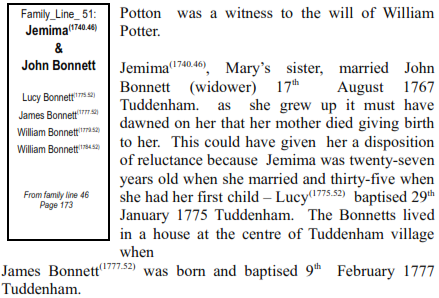
William Bonnett(1779.52) baptised 12th September 1779 Tuddenham died that same year.
The next boy born in May 1784 was named after him. William Bonnett(1784.10) baptised 23rd May 1784 also died at birth .
Sadly, history repeated itself. Just as Jemima's mother died giving birth so Jemima died giving birth. Both mother and child were buried together on 17th December 1784 Tuddenham. Jemima was just forty-four.
